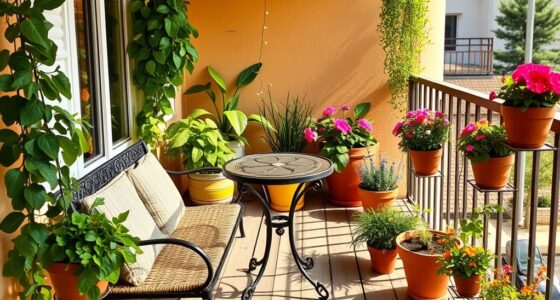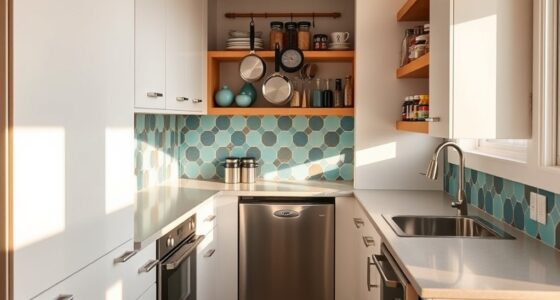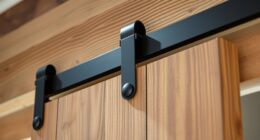To create zones in your studio apartment, use rugs and contrasting colors to visually separate areas like sleeping and living spaces. Position furniture strategically, such as back-to-back sofas or bookcases, to define different zones while maintaining openness. Incorporate movable screens, curtains, or modular partitions for flexible privacy, and add layered lighting to highlight each area. Combining storage solutions with smart furniture placement can further enhance the layout—continue exploring for more ideas to maximize your space.
Key Takeaways
- Use rugs and contrasting colors to visually define separate areas within an open-plan studio.
- Incorporate movable partitions, curtains, or lightweight dividers for flexible, non-permanent zoning solutions.
- Strategically arrange furniture, such as back-to-back sofas or bookcases, to create clear functional zones.
- Utilize lighting layers and color temperature adjustments to visually differentiate and enhance designated spaces.
- Employ multi-purpose furniture like storage beds or foldable pieces to maximize space and establish distinct zones.
Using Rugs and Color to Visually Separate Areas
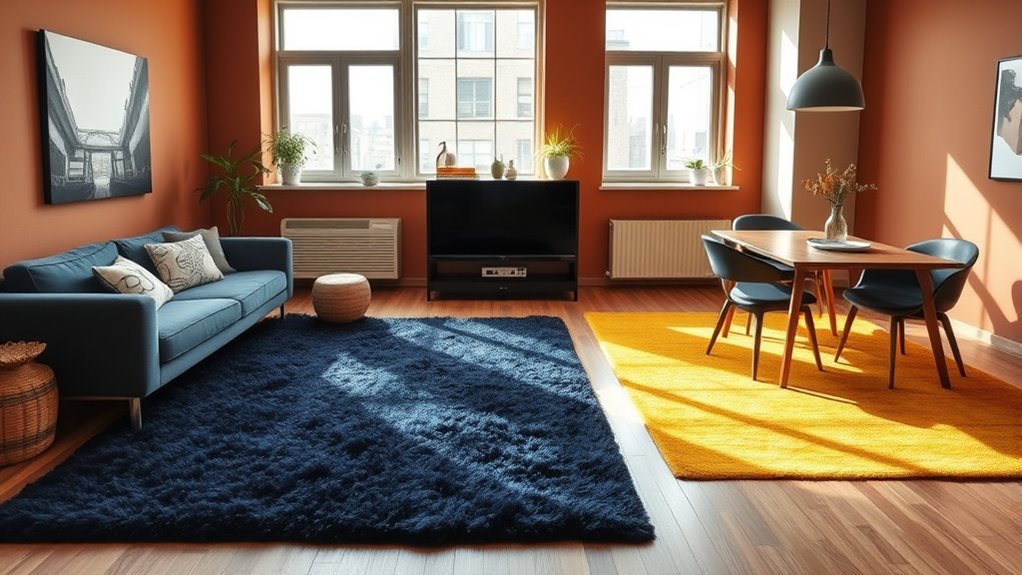
To effectively define separate zones in your studio apartment, using rugs and color is a practical strategy. Rugs create visual separation by forming distinct islands that help define zones within an open-plan space.
Choosing contrasting colors or patterns on your rugs enhances perception, making each area stand out—think bold geometric designs for the living space or neutral tones for the sleeping zone. Layered textures and varied patterns add depth and clarity, offering clear spatial delineation without physical barriers.
Incorporating color psychology principles can also influence the mood and functionality of each zone, helping you create a more harmonious living environment. Coordinating rug hues with wall or furniture tones further reinforces the separation, like warm-toned rugs for cozy corners or cool shades for work or relaxation areas. Strategically placing rugs under key furniture pieces anchors your layout, visually compartmentalizing the open-plan design.
Strategic Furniture Placement for Functional Zones
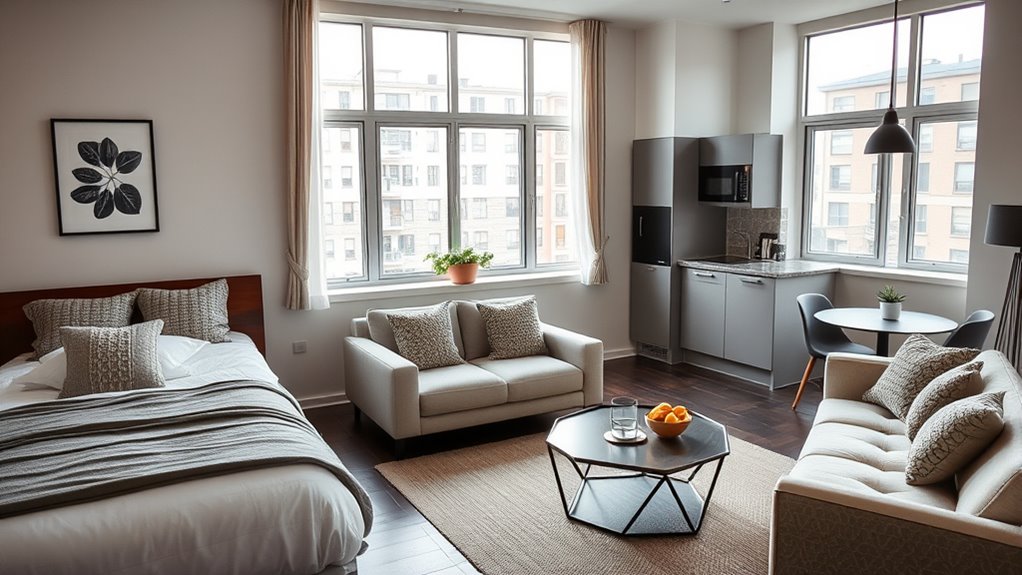
To define different zones, you can arrange larger furniture pieces like sofas and beds against walls or in corners to create distinct areas while keeping the space open. Incorporating shelving units or bookcases perpendicular to walls acts as visual dividers that also serve functional purposes. Choosing dual-purpose furniture, like a sofa bed or storage ottoman, adds flexibility and helps tailor each zone to your daily needs. Additionally, using innovative planters can add a decorative element while subtly delineating spaces within your studio. Incorporating sound-absorbing materials such as rugs or curtains can further enhance the separation by reducing noise transfer between zones. For a cohesive look, consider coordinating the color palette across zones to enhance visual harmony. Integrating proper lighting can also help define each area and set the desired mood. In some cases, using electric bikes as a stylish and eco-friendly transportation option can also influence how you organize your space, especially if you need a dedicated area for storing or charging your bike.
Furniture Arrangement Techniques
Strategic furniture placement is essential for creating distinct zones within a studio apartment, making the space feel organized and functional. By arranging furniture in back-to-back or L-shaped configurations, you can clearly define areas like the living and dining spaces. Incorporate visual barriers such as taller furniture—bookcases or wardrobes—along shared walls to subtly separate zones without physical walls. Positioning furniture diagonally or at angles helps break up open floor plans, maintaining flow while delineating activity areas. Multi-purpose furniture, like a sofa bed or storage ottoman, offers flexibility for changing needs, enhancing space division. Additionally, considering privacy policies and user consent options can help ensure your space remains comfortable and adaptable for various needs. Being mindful of safety precautions when arranging furniture is also important to prevent accidents and ensure easy movement throughout the apartment. Creating mindful living through thoughtful layout enhances both comfort and functionality in a compact environment. When planning your layout, it’s helpful to study space utilization strategies to maximize every square foot effectively. Always consider room layout and furniture placement to leave open pathways, ensuring easy movement and clear separation of functional zones within your compact space. Incorporating furniture with built-in storage can further maximize space and reduce clutter, contributing to a more organized environment.
Dual-Purpose Furniture Options
In a small studio, dual-purpose furniture plays a crucial role in maximizing space and defining functional zones. Using multifunctional pieces, like sofa beds or fold-down tables, helps optimize space division by serving multiple purposes in a single area. Additionally, understanding how to manage odor indicators can help maintain a fresh environment across different zones. Convertible furniture, such as Murphy beds or fold-away desks, offers flexible furniture solutions that adapt to your needs, making room zoning easier. Built-in storage options, like beds with drawers or storage ottomans, keep belongings organized while subtly delineating zones. Strategically placing a bookshelf or low partition creates visual boundaries without sacrificing openness. Multipurpose furniture allows you to switch between living, working, and sleeping spaces seamlessly, making your studio more practical and comfortable. Incorporating space-saving solutions can further enhance the functionality of your layout, ensuring every square inch works harder for you. Utilizing compact furniture designs can also optimize your layout by reducing clutter and creating a more open feel. To optimize your layout, considering room organization techniques can also help you create a more efficient and clutter-free environment.
Employing Lighting to Define and Enhance Spaces
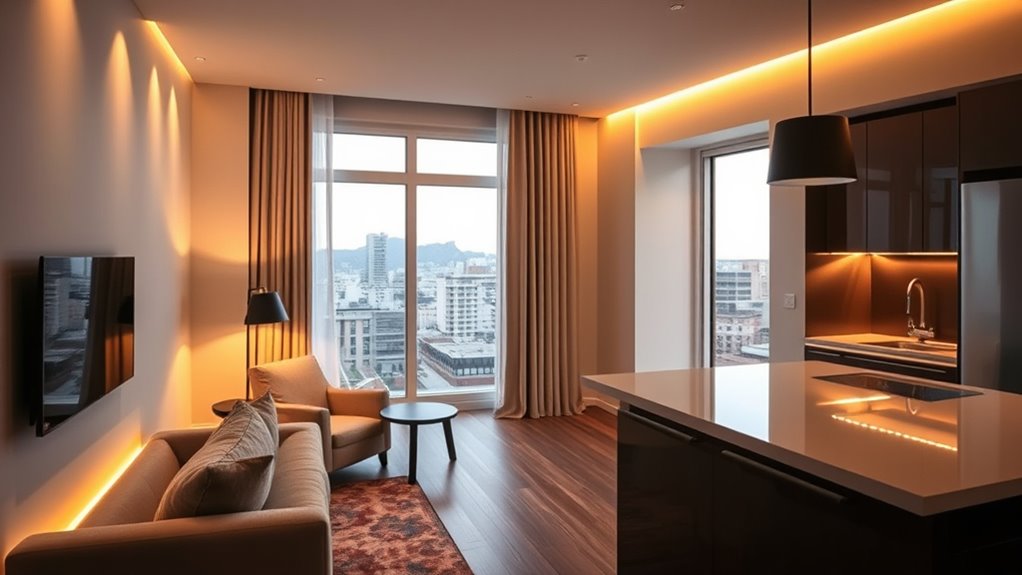
Using layered lighting techniques helps you clearly define different zones while adding depth and visual interest. You can control mood and ambiance by adjusting light levels with dimmers or choosing specific fixtures. Task and accent lighting further highlight key areas, making each space functional and inviting. Incorporating lighting styles that complement your decor enhances the overall aesthetic and atmosphere of your studio apartment. Additionally, selecting appropriate bulbs can influence the warmth and color rendering, further tailoring your space’s ambiance. Being aware of lighting trends can also help you stay current and stylish in your design choices. For example, understanding the typical store hours of popular beauty retailers can assist you in planning visits for supplies to enhance your ambiance and lighting setup. Properly managing lighting placement is essential to prevent glare and shadows, ensuring a comfortable and visually appealing environment.
Layered Lighting Techniques
Layered lighting is essential for defining and enhancing different zones within a studio apartment, especially since open layouts lack physical barriers. By combining layered lighting—ambient, task, and accent—you create visual separation and improve spatial perception. Using dimmable fixtures allows you to adjust light levels, highlighting specific areas like the kitchen or lounge without overwhelming the space. Thoughtful light placement, such as wall sconces, pendant lights, or floor lamps, emphasizes zones and offers clarity. Accent lighting draws attention to decorative elements, while task lighting ensures functionality in work or cooking areas. This layered approach makes your space feel more structured and spacious, helping each zone stand out while maintaining a cohesive and inviting environment. Additionally, incorporating lighting controls can further enhance flexibility and user comfort in your living space. Proper placement and selection of lighting fixtures can also reduce shadows and create a balanced ambiance throughout your apartment. Incorporating popular lighting styles, such as modern or minimalist designs, can further elevate the aesthetic appeal and functionality of each zone. Understanding lighting placement principles is crucial to achieving a well-balanced and harmonious lighting scheme that complements your overall interior design.
Mood and Ambiance Control
Have you ever noticed how different lighting settings can instantly change the mood of a space? Lighting plays a vital role in defining and enhancing zones within your studio.
By adjusting color temperature—warm, soft light for relaxation areas and bright white for workspaces—you visually differentiate these zones. Layered lighting, including overhead fixtures, task lamps, and accent lights, adds depth and subtly signals different functions.
Dimming switches and smart systems let you fine-tune light levels, enhancing ambiance and creating a cozy or energizing atmosphere as needed. Highlighting specific features with accent lighting, like art or desks, draws focus and establishes boundaries.
Strategic use of lighting shapes mood and ambiance, making your studio feel more spacious, organized, and inviting. Effective preparation for lighting layout can maximize the functionality and aesthetic appeal of your space.
Task and Accent Lighting
Task and accent lighting are essential tools for defining and enhancing different zones in your studio apartment. Task lighting, like desk lamps or under-cabinet lights, provides focused illumination for workspaces and cooking areas, improving functionality and visual clarity.
Accent lighting, such as wall sconces or LED strips, adds visual interest and highlights architectural features or décor, emphasizing the unique character of each zone. Using dimmers helps you set the perfect mood and creates visual separation by contrasting bright task areas with softer, relaxed spaces.
Adjusting color temperature—cool white for work zones and warm white for relaxing areas—further distinguishes each space. Strategic lighting fixture placement directs attention, defines spatial boundaries, and enhances the overall sense of organization within your open-plan studio.
Incorporating Movable and Temporary Dividers
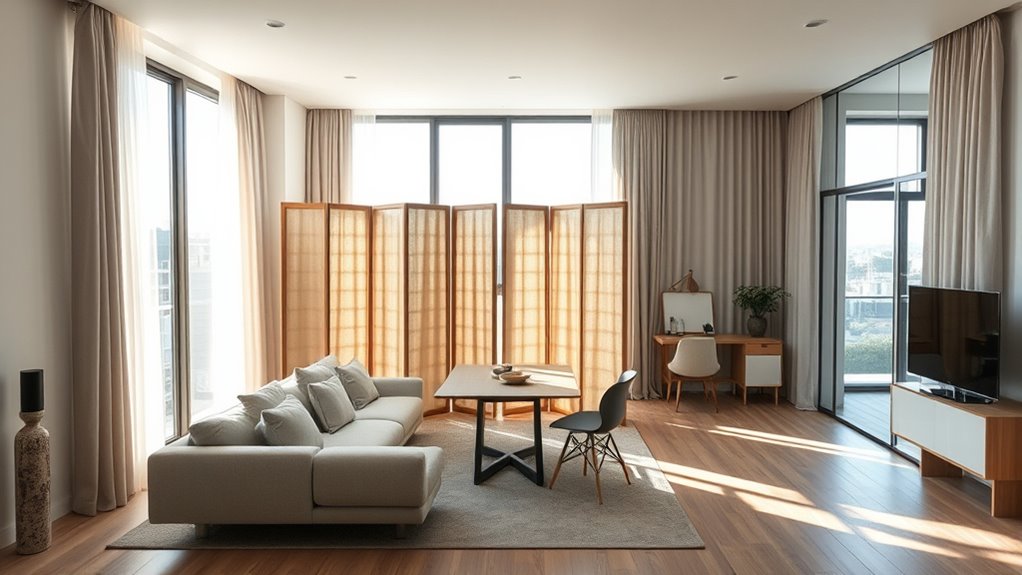
Incorporating movable and temporary dividers allows you to adapt your studio apartment’s layout quickly and effortlessly. Movable dividers, like fabric curtains, folding panels, and freestanding screens, enable flexible space management and room separation without permanent changes.
Installing fabric curtains or fabric drapes around alcoves creates privacy and visual boundaries that you can open or close as needed. Freestanding screens made of wood or modular panels can be repositioned to redefine zones, offering adjustable privacy.
Sliding or portable panels on built-in tracks facilitate quick transformation of open areas into private spaces, perfect for changing needs. Lightweight, multi-purpose furniture such as collapsible partitions enhances versatility, allowing you to optimize your studio layout while maintaining a dynamic, adaptable environment.
Building Non-Permanent Structural Partitions
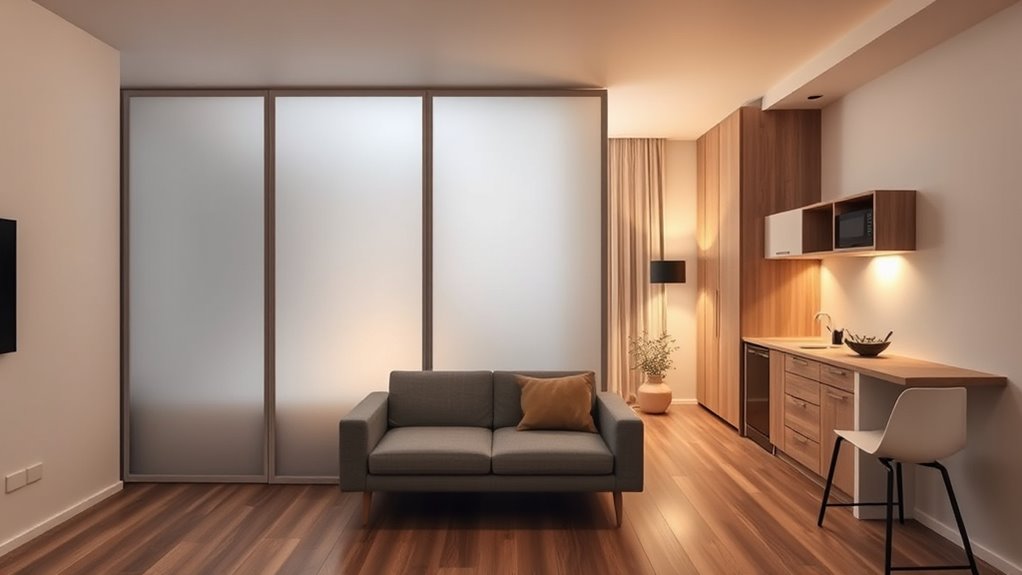
Building non-permanent structural partitions offers a versatile way to create private zones and define different areas within your studio apartment without permanent renovations. Movable walls, room dividers, and modular dividers allow you to customize your space easily, providing privacy and separation when needed.
Temporary partitions like curtains or sliding panels can be repositioned or removed, giving you a flexible space that adapts to your lifestyle. Lightweight materials such as fabric, acrylic, or metal frames make these partitions easy to install and store.
Proper placement of these non-permanent structures helps you establish functional zones, enhance privacy, and maintain an open feel. With these options, you can enjoy the benefits of separate areas without sacrificing the apartment’s overall openness.
Utilizing Vertical Space and Plants for Boundaries

Maximizing vertical space is an effective way to define boundaries in a studio apartment without sacrificing floor area. By installing loft beds, stacking shelving units, or tall storage cabinets, you create distinct zones through space division that enhance interior design.
Incorporate plants, such as hanging planters or tall indoor greenery, to add natural elements that visually separate areas and boost privacy. Vertical gardening and plant stands leverage wall height, forming natural room boundaries while enriching the environment.
Strategically placing large, leafy plants near sleeping or working zones creates subtle barriers, delineating functions without walls. Combining vertical space solutions with well-placed furniture and lighting reinforces boundaries, making your studio more functional and visually appealing while maintaining an open, airy feel.
Creating Privacy With Curtains and Screen Panels
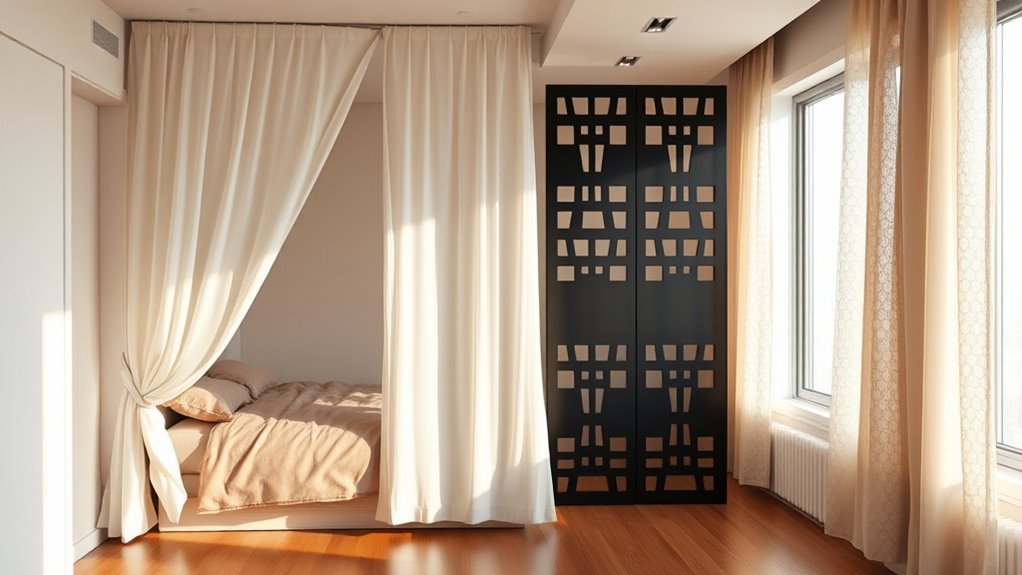
Ever wonder how to create private zones in your open-plan studio without permanent walls? Curtains and screen panels are perfect solutions.
Floor-to-ceiling curtains can be easily installed around beds or alcoves, offering a soft partition that enhances privacy and adds style.
Movable screen panels, such as fabric or wooden slats, allow you to temporarily divide spaces or adjust layouts as needed.
With ceiling-mounted rods or curtain tracks, opening and closing these dividers is smooth, giving you flexibility to adapt your space.
These options are budget-friendly, require minimal installation, and can be customized with different colors, patterns, or materials to match your decor.
Using curtains and screen panels is an effective way to create privacy while maintaining an open, versatile studio apartment.
Designing Multi-Purpose Furniture for Flexibility
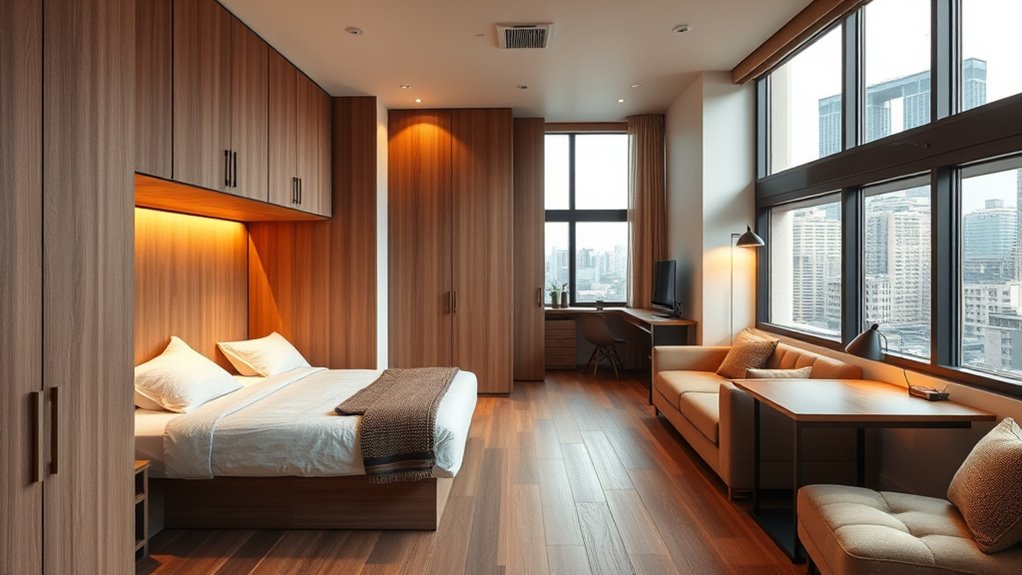
Designing multi-purpose furniture is essential for creating a flexible layout in your studio apartment. Multi-purpose furniture, like sofa beds and foldable tables, maximizes space by serving dual functions—such as seating and sleeping or dining and working.
Modular furniture systems are adaptable, allowing you to reconfigure pieces to suit your changing needs, enhancing flexibility.
Built-in storage integrated into beds or seating helps reduce clutter while defining zones.
Convertible furniture, including Murphy beds or nesting tables, transforms quickly, optimizing space efficiency.
Movable furniture, like lightweight chairs or carts, makes it easy to rearrange zones, creating versatile environments throughout your apartment.
Combining Storage Solutions With Spatial Division
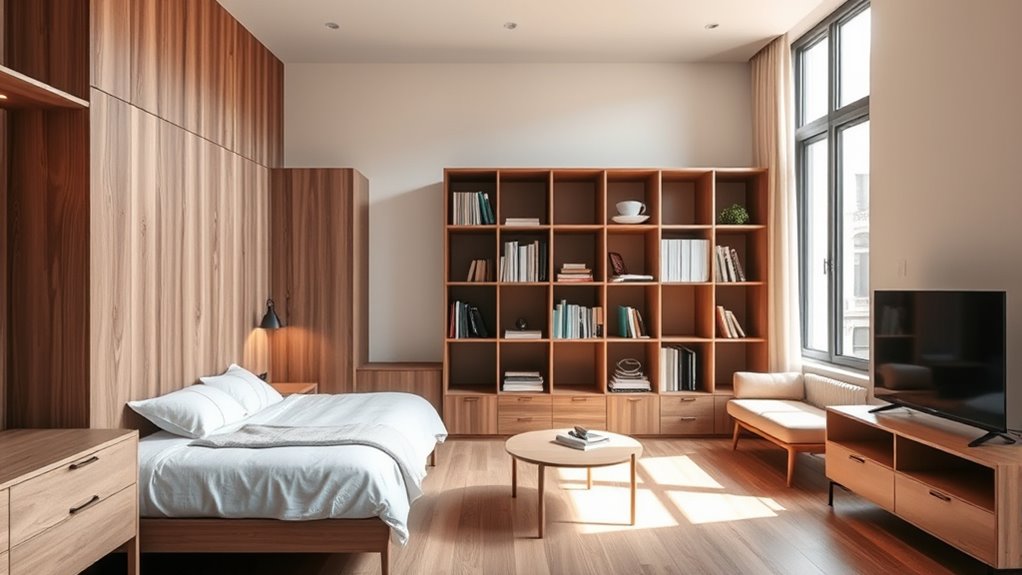
In a studio apartment, combining storage solutions with spatial division can transform an open-plan space into functional zones without sacrificing flow. Use built-in or freestanding storage, like wardrobes or cabinets, as visual dividers that enhance organization and define zones. Multi-purpose furniture such as storage beds with drawers or sofa beds with hidden compartments streamlines space while creating designated areas. Creative dividers like clothing racks or open shelving units act as versatile solutions, maximizing vertical storage and establishing visual boundaries. Strategic furniture placement, such as back-to-back sofas or positioned bookcases, further separates zones without blocking openness. This approach ensures that your storage needs are met while maintaining a cohesive, visually appealing environment.
| Storage | Dividers | Multi-purpose |
|---|---|---|
| Wardrobes | Clothing racks | Storage beds |
| Cabinets | Open shelving | Sofa beds |
| Vertical units | Patterned walls | Multi-use furniture |
| Hidden compartments | Artwork | Color-blocked walls |
Frequently Asked Questions
How to Create Zones in Studio Apartment?
You want to define different areas in your studio apartment, and there are simple ways to do it. Use rugs, artwork, or wall colors to visually separate spaces.
Arrange furniture like back-to-back sofas or multi-purpose pieces to create distinct zones.
Add lighting to highlight specific areas, and incorporate movable partitions like curtains or folding screens for flexible reconfiguration.
Use storage and decor to reinforce each area’s purpose.
How to Create Sections in a Studio Apartment?
When it comes to creating sections in your studio apartment, think of it as killing two birds with one stone. You can use visual dividers like rugs or artwork to subtly separate areas.
Furniture placement works wonders—arrange pieces to define spaces, and add curtains or screens for temporary partitions.
Don’t forget vertical space; lofted beds or platforms can clearly differentiate sleep zones, while strategic lighting highlights each section, making your space feel larger and more organized.
What Are 5 Ways to Create Defined Zones in an Open Concept Space?
You want to create defined zones in an open space. Use area rugs to visually anchor furniture and separate areas without walls. Arrange furniture strategically, like back-to-back sofas or shelves, to form natural boundaries.
Add accent walls or contrasting colors to distinguish spaces. Incorporate movable partitions, such as curtains or screens, for flexible separation. Finally, vary your lighting with task or ambient lights to highlight different zones and set moods.
How to Organize a Studio Apartment?
Organizing a studio apartment is like arranging a symphony—you want everything in harmony. Start by defining zones with visual dividers like rugs or artwork.
Use flexible furniture to adapt your space. Strategically place furniture to create natural boundaries, and employ curtains or shelving for privacy.
Maximize vertical space with lofted beds or platforms, keeping your layout functional and inviting while maintaining an open, airy feel.
Conclusion
Just like a master painter shapes a blank canvas, you can craft a harmonious, functional studio space. By mixing rugs, furniture, lighting, and clever dividers, you create zones that feel natural and inviting—no Herculean effort needed. Think of it as your own modern Atlantis, where each element reveals your style and needs. With a little creativity, your apartment becomes a masterpiece, perfectly balanced and uniquely yours—proof that even in small spaces, big dreams can thrive.


